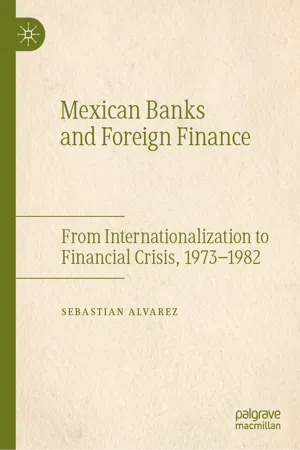The international debt crisis of the 1980s was the first global financial meltdown of the postwar era and represented a new wave of sovereign debt crises since the Great Depression of the 1930s. After the declaration of the moratorium on external debt principal payments by the Mexican government in August 1982, an increasing number of heavily indebted countries in the developing world come also under debt payment difficulties following the same path. The scale and extent of the defaults were a major threat for the international financial system because the amount of external debt in troubles represented several times the capital base of the world’s largest banks. The outbreak of the crisis brought into an end the foreign bank lending boom to developing countries, particularly to Latin America, that had developed within the Euromarkets after the rise of international liquidity that followed the oil shock of 1973.
In the literature on the foreign debt boom leading to the crash of 1982, commercial banks from developed countries have attracted the lion’s share of scholarly attention.1 There are good reasons for their prominence since major US and European banks were the main depository institutions of the large surpluses of oil-exporting countries, and they were the largest international lenders to the developing world. Also because, working together with them, a great number of other industrial countries’ banks operating in London or connected to the world capital markets from their home countries were contributing to sovereign lending and taking part of syndicated credit deals through the Euromarkets. The banking industry of developed countries accounted indeed for the large majority of the international financial operations and capital flows, and they were in possession of the bulk of developing countries’ external debt by the time of the outbreak of the crisis.
However, international finance and Euromarket activity were not limited to financial institutions from the industrial world. A closer look at the members of some syndicated lending operations reveals the presence of financial institutions from developing countries as well. In the case of Latin America, as this chapter shows, the most important banks of the region, notably from Brazil, Mexico and Argentina, were also involved with foreign finance and Euromarket operations. With a physical presence in the main world financial centers of the time, as shareholders of consortium banks or through their own agencies and branches, these banks gained access to the Eurocurrency interbank market and raise funds that they then used to finance the expansion of their international businesses. Like their counterparts from developed countries, Latin American banks were also participating in the so-called petrodollar recycling process and sovereign lending operations to their home countries.
There is little doubt that the volume of international lending of Latin American institutions was meager when compared to that of US, European or Japanese banks and that the amount of capital that they controlled represented only a minority of the Euromarkets and world capital flows. Neither were Latin American banks the main suppliers of funds to their home government or other public or private companies borrowing abroad. Nevertheless, by intermediating foreign capital with domestic borrowers these banks were intrinsically intertwined with the external indebtedness process of their countries, which means not only that they were involved in the creation of the crisis but also exposed to it. Moreover, because these banks were usually large domestic financial actors and the volume of international operations represented a significant part of the banking system, their potential problems represented a systemic threat for the domestic economies.
Mexico and the Global Crisis
On Friday August 20, 1982, in a meeting held with foreign bankers at the FRBNY, Mexican officials announced to the international financial community that they could no longer service its external debt. During previous weeks, Mexico’s economic and financial authorities had already been in contact with their US counterparts regarding the insufficient reserves of the country to meet its external b...
